Turnip can hardly be called an exotic vegetable, but still, quite few of us can describe its taste clearly unless we make use of this root crop regularly in our kitchen. And since cooking implies being aware of the taste and scent of all the ingredients, people often wonder about the turnip taste.
So today we decided to help you to learn what turnips taste like and how to make use of this foodstuff to fully enjoy its flavor and nutritious value.
What Does a Turnip Taste Like?
To say it simply so that everyone could understand, the taste of turnip is somewhere in between the tastes of cabbage and radish. It is the same sweet with a bit peppery notes in it, and it has the very same crispy white insides.
However, we need to take into consideration that the sort of this root crop, as well as its age will influence the flavor and taste. This nuance often becomes crucial when it comes to choosing a veggie to cook it. So what could the distinctions be?
- Young root crops (also known as baby turnips) usually have tender and crunchy flesh with quite a noticeable sweetness. They can be consumed both raw and cooked, but it is important to remember that some varieties may taste a bit more tangy.
- Older root crops tend to change their taste quite significantly. It gets noticeable spicy hints, and the overall flavor shifts to a woodier one. This is also the reason why older turnips need to be cooked since if we eat them raw, the taste will appear to be too bitter. Thermally processed, they will, on the contrary, get a very delicious sweetness!
And even though we normally don’t use turnip for daily cooking needs, it is good to know what makes it different from the other most common root crops with a similar texture and taste profile, such as potatoes and rutabaga.
[table id=127 /]
So whenever you decide to incorporate this root crop into your daily cooking routine, we would recommend paying attention to the age of the veggies you purchase. If you are going to cook something that requires delicate taste, a young turnip will definitely be a better choice!
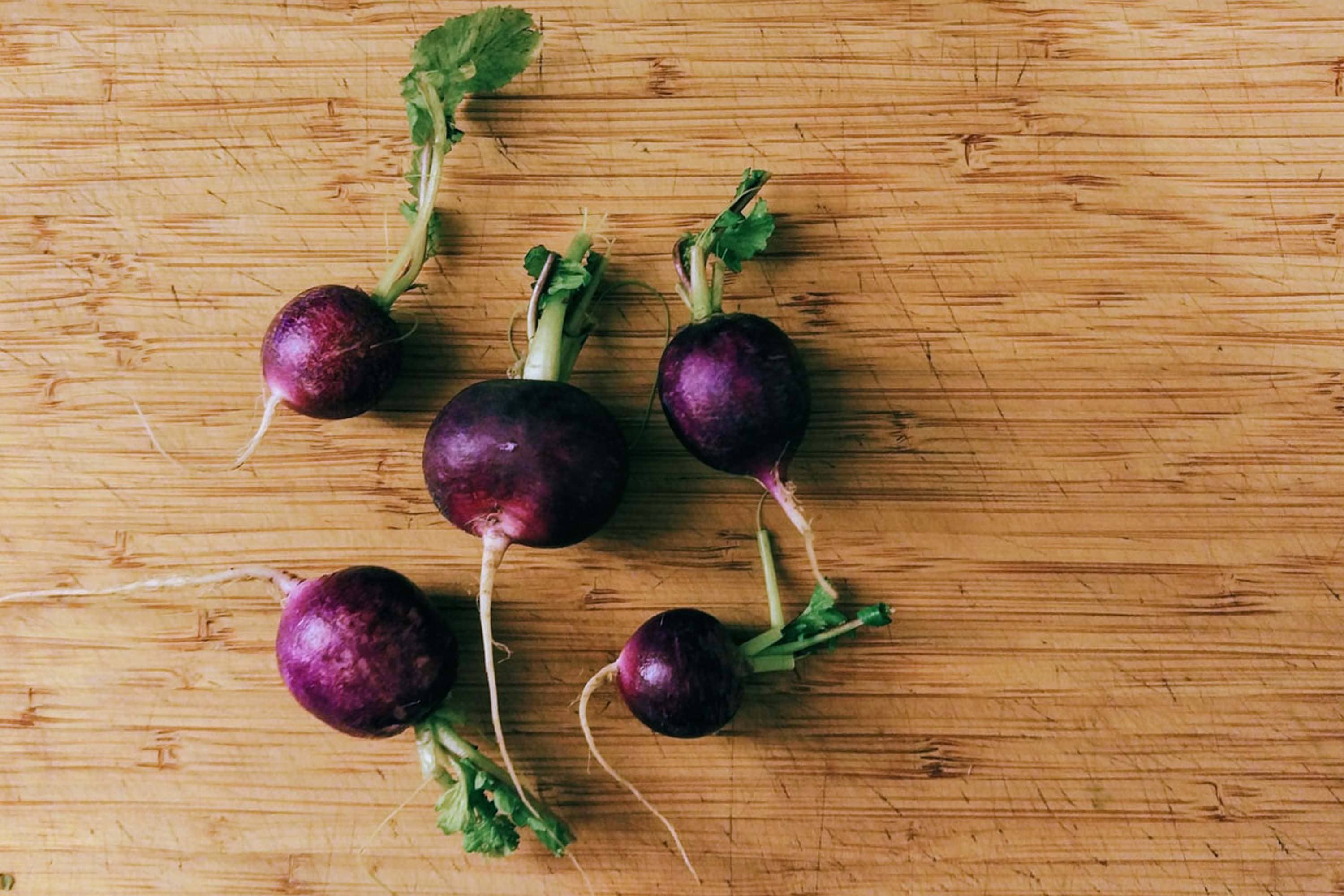
Do Turnips Taste Like Potatoes?
Generally speaking, the taste of these two can’t be called absolutely similar.
When it comes to the turnip vs potato taste issue, the opinions split. Some people find the tastes of these two root crops pretty similar, but we would not be that sure. As you already know, turnip tastes like a mix of radish and cabbage. Potatoes, on the contrary, have a somewhat different taste profile that includes creamy notes with a subtle and mild sweetness.
Nevertheless, turnip is an ideal substitute for potatoes in terms of its texture, so if you don’t mind the taste much, consider using one instead of another to make the dishes more varied.
What Do Turnip Greens Taste Like?
As we know from our friends from PreparedCooks.com – quite a few people know that the greens and leaves of turnip are also edible. We talked with our friends from . Nevertheless, it is true. And when it comes out, home chefs start wondering what the turnip greens taste is.
Such a curiosity is reasonable since we need to know what the taste of the final dish will be if we add something to it that is not a common ingredient (and let’s agree, we don’t make use of turnip leaves of greens that often!).
So, regarding the taste, turnip greens are pretty much the same as the root crop itself having very similar peppery notes which means you can incorporate them into any dish that implies the use of the veggie. Be ready though that turnip greens may have that significant tingle which will disappear pretty soon.
Its leaves, on the other hand, may have milder taste.
A Bit About the Turnip Smell
When it comes to figuring out turnip flavor profile, we usually expect this root crop to have pretty much the same aroma as its relatives (potatoes and rutabaga) have. And basically, it is the right assumption. However, turnip scent will also have those quite significant mustard-like notes that are common for cabbage and broccoli.
What we do have to be aware of is that overcooking this root crop is strongly not recommended: if we boil turnip for too long, we will get the same effect that takes place when we cook cabbage too much. The root crop will produce that peculiar strong sulfur smell that is not the best thing to sniff.
What’s a Turnip?
So what is this veggie in fact? It is often mistaken to rutabaga, and people often think turnip is a close relative to potatoes, but everything is not that simple.
This root crop is in fact closely related to radishes and mustards having quite similar taste and aroma. Turnip has the same white insides that are crispy and slightly sweet, with very mild peppery notes.
Besides, turnip greens that grow right from the above-ground part of the veggie are known for having almost the same flavor as mustard greens.
In terms of shape, this veggie is roughly globular, being around 5 to 20 cm in diameter with a long taproot that is usually cut off before the veg arrives to the stores for being sold.

How to Make Turnips Taste Good? Cooking Tips And Suggestions
Since turnips may have quite significant bitter notes and old veggies must always be consumed in a cooked form, being able to prepare this root crop becomes an essential skill. Fortunately, turnips are rather versatile stuff in terms of culinary, and besides, there are plenty of recipes that ask for this veggie and offer delicious and nutritious meals.
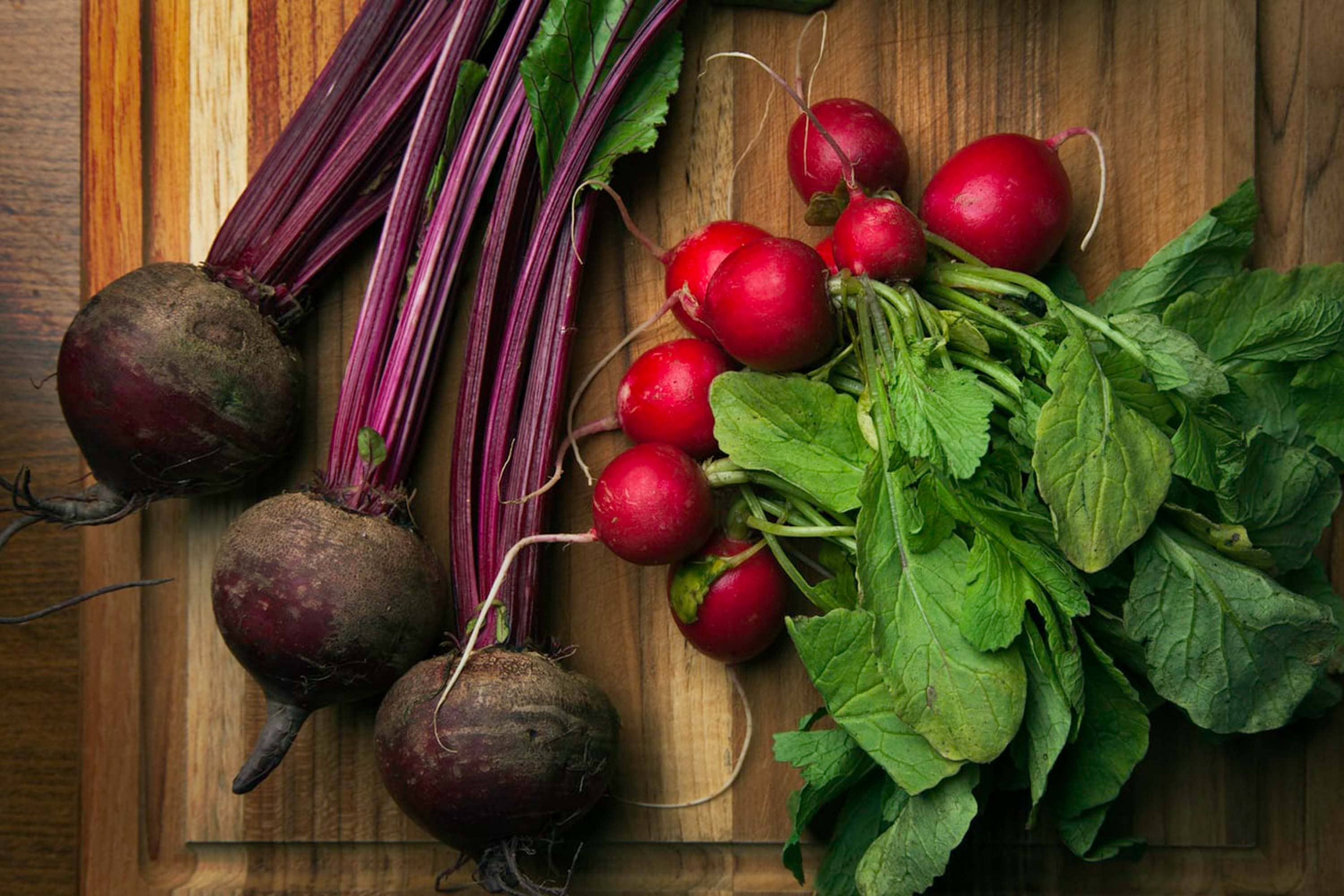
- Turnips can be oven-baked or roasted
- We can cook them by boiling, too
- Fried turnips will complement any side dish on your dinner table
- Stick to steamed turnips if you are into healthy eating with no frying
- Tired of mashed potatoes? Why not try out some mashed turnips? With garlic oil and herbs, this simple yet tasty meal will definitely please your taste buds!
The only thing we need to keep in mind is that for cooking turnips the root crops must always be peeled! Also, if you are going to use old veggies, consider adding salt, garlic, andbutter (or cream) to the dish. Those ingredients will decrease the bitterness and make the root crop taste milder and creamier.
Turnip is a very versatile veggie for cooking, it is simple to prepare and its low price makes this root crop a very affordable foodstuff. With the mild and slightly spicy taste, it can become a worthy part of your daily cooking making it more varied.
7 Creative Ways to Cook With Turnips
Turnips may seem to be quite a boring root vegetable in terms of cooking! Let’s agree, most of us still believe it is only possible to boil it or bake in the oven. Well, maybe, someone enjoys it raw, who knows?
However, this vegetable can be cooked in multiple ways which means that humble turnips can turn into your favorite staple one day!
- Cook it a la Matignon. Simply cut it to a uniform size for use as a complement in a variety of fried or braised dishes alongside carrots, potatoes, and leek.
- Try pickled turnips! Its crisp texture and sweet flavor makes this veggie a perfect pick for pickling. Just halve smaller varieties of this root, such as Tokyo turnips, submerge them in a white vinegar-based brine, and refrigerate like this for a week.
- Fried turnips with eggs may also become your favorite dish choice for breakfast. Fry small diced turnips in a skillet for a hash topped with fried egg.
- Turnips also fit salads ideally. Slice it thin like radishes, or serve this veggie whole as a crudite platter, e.g. baby turnips.
- Try to add it to your gratin alongside potatoes. Potatoes will balance the soft sweetness of turnips with their sturdy texture to make an ideal dinner.
- Pick young and small turnips and steam them to enjoy their natural delicate sweetness.
- Finally, don’t forget about such a simple dish as mashed turnips! Slightly sweet and way more delicate (compared to potatoes) turnips will complement a rich braised meaty main perfectly.
With these tips, you can easily make your dinner menu more varied by using just one vegetable in many distinct ways!

The Recommended Turnip Cooking Methods
Since we have figured out that turnips can be cooked using many different methods, a reasonable question appears: which of them is the optimal one? Since some cooking methods, such as frying or boiling, leave vegetables with almost no nutrients left in them, knowing how to cook your food is really important.
So regarding turnips, the best cooking method that you can use would be roasting or steaming. Both of these ways have very low heat impact on a vegetable meaning that turnips will save all the vitamins, nutrients, and other beneficial elements it contains.
In addition, these cooking methods preserve the natural taste and texture of this veggie which allows you to enjoy it almost as if it was raw!
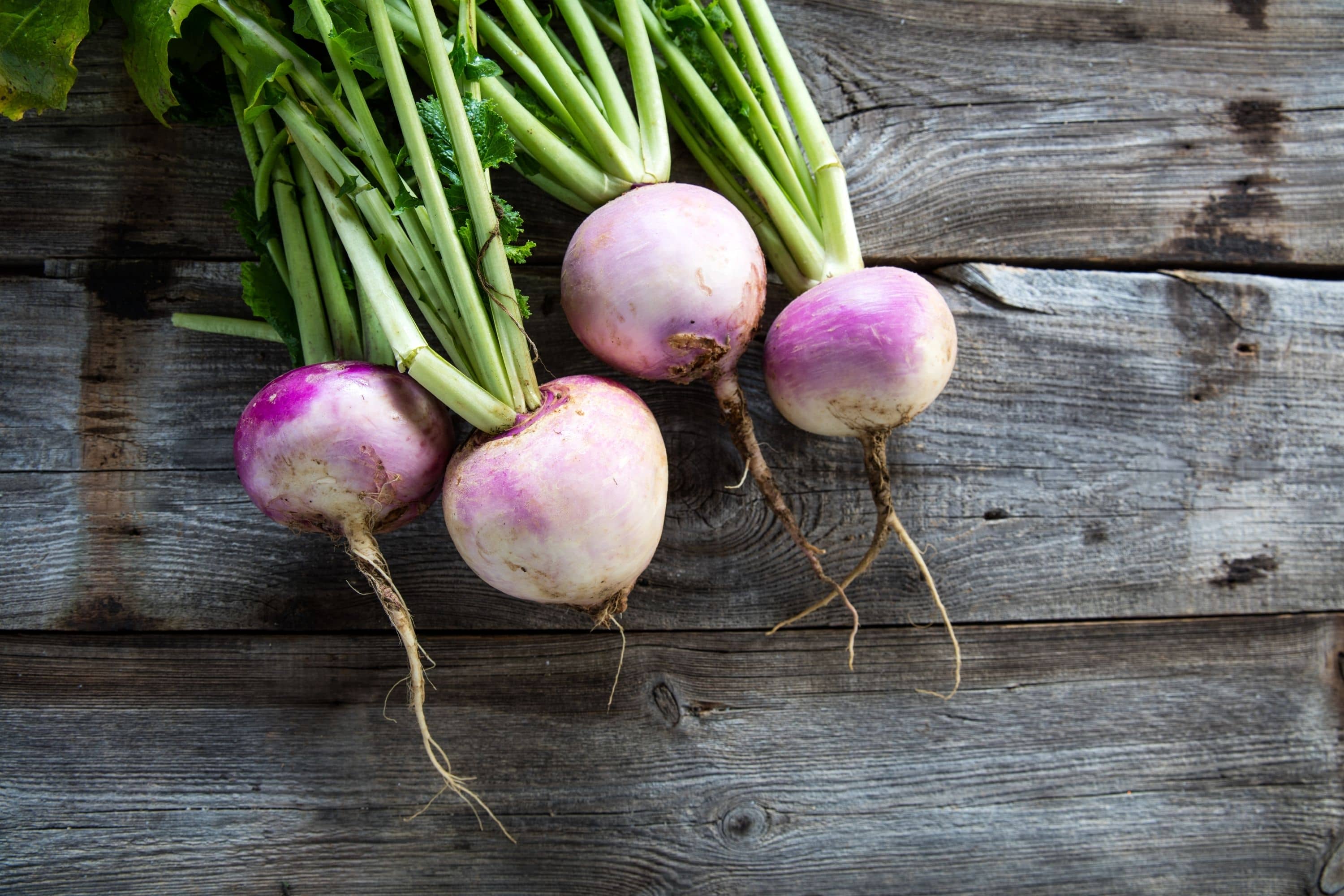
How to Roast Turnips
Roasting turnips is one of the easiest and best ways of cooking this vegetable. It doesn’t take much time, and the root comes out of your oven being delicate, delicious, and so flavorus! Such a perfect mellow and caramelized crowd pleaser!
In addition, roasting it is very simple.
- Slice off the root end and peel your turnips if it is larger than a few inches in diameter.
- Dice it into medium-size pieces and sprinkle with one or two spoonfuls of olive oil. Add salt and pepper, or any other spices that you like.
- Preheat your oven to 400 F, spread diced turnips in a single layer on a baking sheet and shove into the oven. Cook until they turn golden brown and crispy, turning them once or twice while roasting.
Serve roasted turnips with other veggies, fish, or – best of all – with any meaty foods.
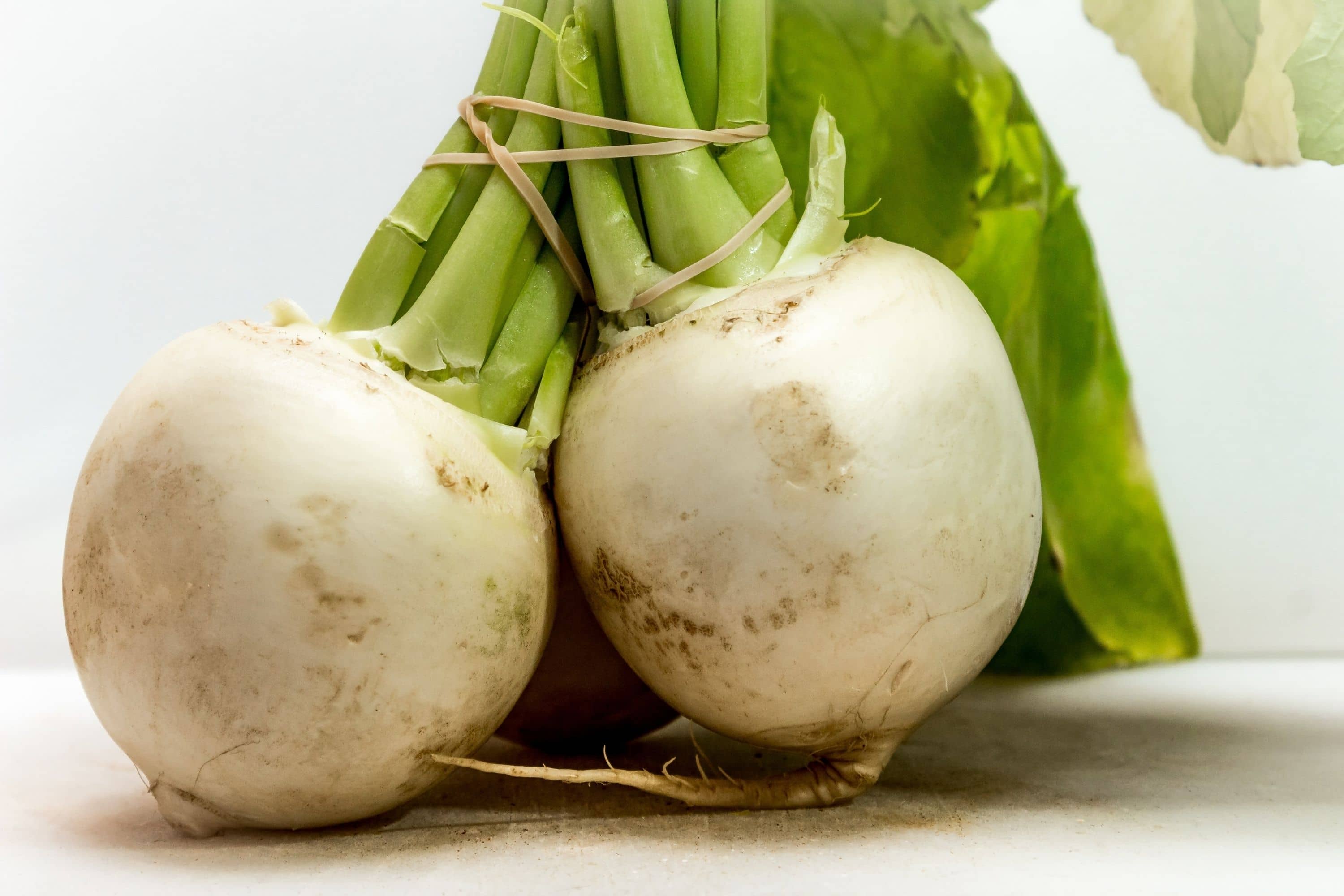
What Is a Good Turnip Substitute?
Why would we want to substitute turnips with something else? Well, maybe, someone prefers a more intense taste. Or perhaps, you simply could not find it in a supermarket because turnips were sold out!
No matter the reason, it is always good to know what vegetables can perform in your dishes instead of it being the closest substitution in terms of taste, texture, and flavor.
- rutabagas
- celery root
- parsnips
- carrots
Use any of them to replace turnips in any recipe that requires this vegetable. In addition, at least one of these vegetables can always be found in a store which means that you will not be left out with no turnips or a similar foodstuff in your dinner dish!
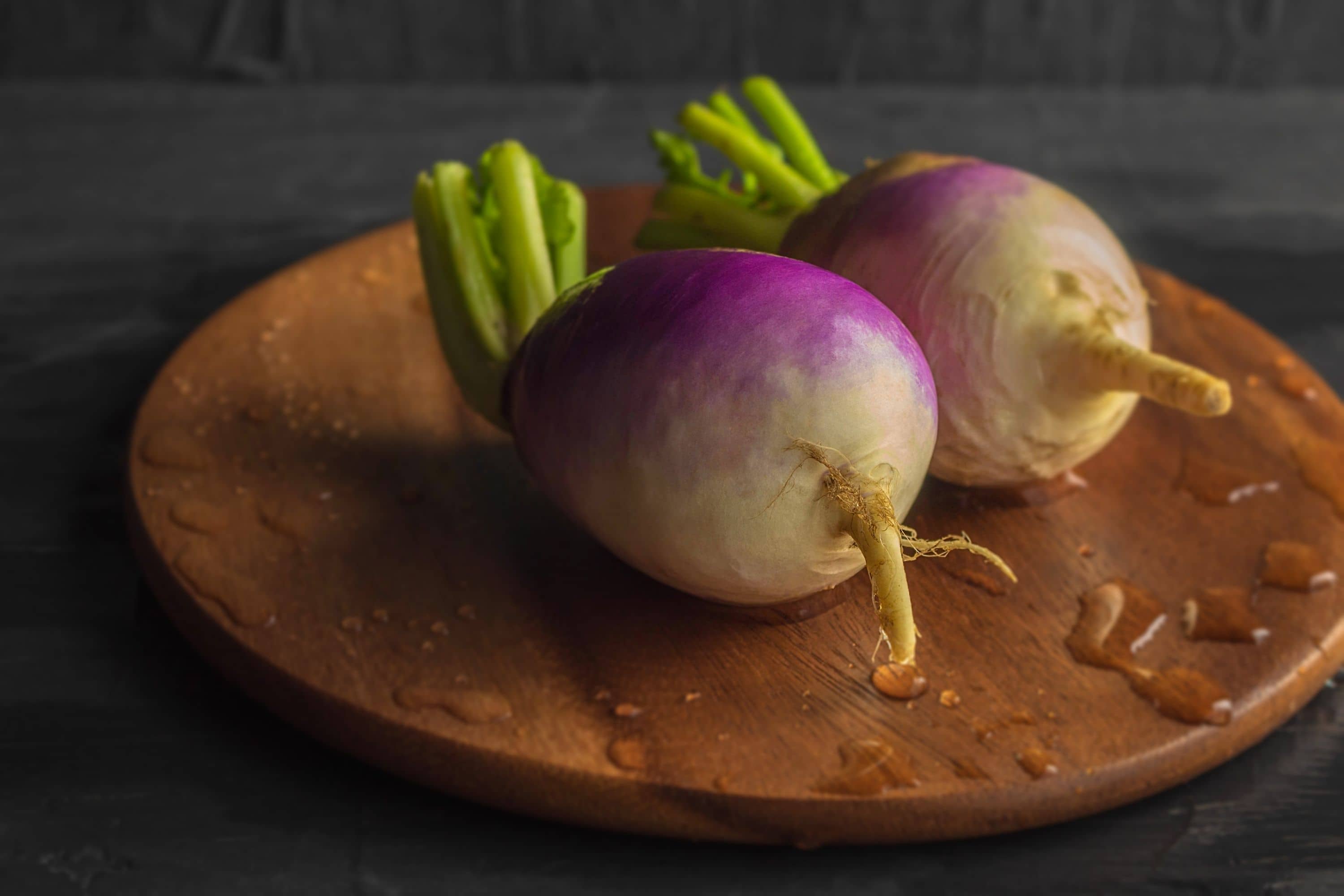
Turnips VS Rutabagas
When choosing between turnips and rutabagas, most of us feel like they are lost because these root vegetables are pretty much alike both in terms of their appearance and taste. In addition, rutabagas are often labeled as yellow turnips which doesn’t make it clearer for the consumers!
However, these two do have certain distinctions:
- Turnips have white flesh
- The skin of a turnip is either white or white-purple
- Turnip is smaller than rutabagas
- Also it is less sweet in comparison to rutabagas
As for the turnip’s alternative, it also has certain recognizable features:
- Rutabagas are bigger than turnips
- They have yellow flesh
- The skin of rutabagas is purple-tinged yellow
- They are also sweeter
Nevertheless, the taste of both is almost the same, with a slightly sweet and snappy flavor.

Turnips VS Radishes
Since turnips and radishes look pretty much the same, people tend to believe that these two vegetables are all alike. However, if we take a closer look at each of them, we will see that this is not like that.
- Turnips and radishes belong to different families
- Radishes are smaller in size
- The skin color of radishes is crimson
- Turnips are white or purple-white
- The taste of turnips is much milder than of radishes
- Radishes have quite a sweet flavor whereas turnips smell spicy
However, both of them are very healthy and help us to boost our immune system and strengthen our health with all the vitamins and microelements they contain.
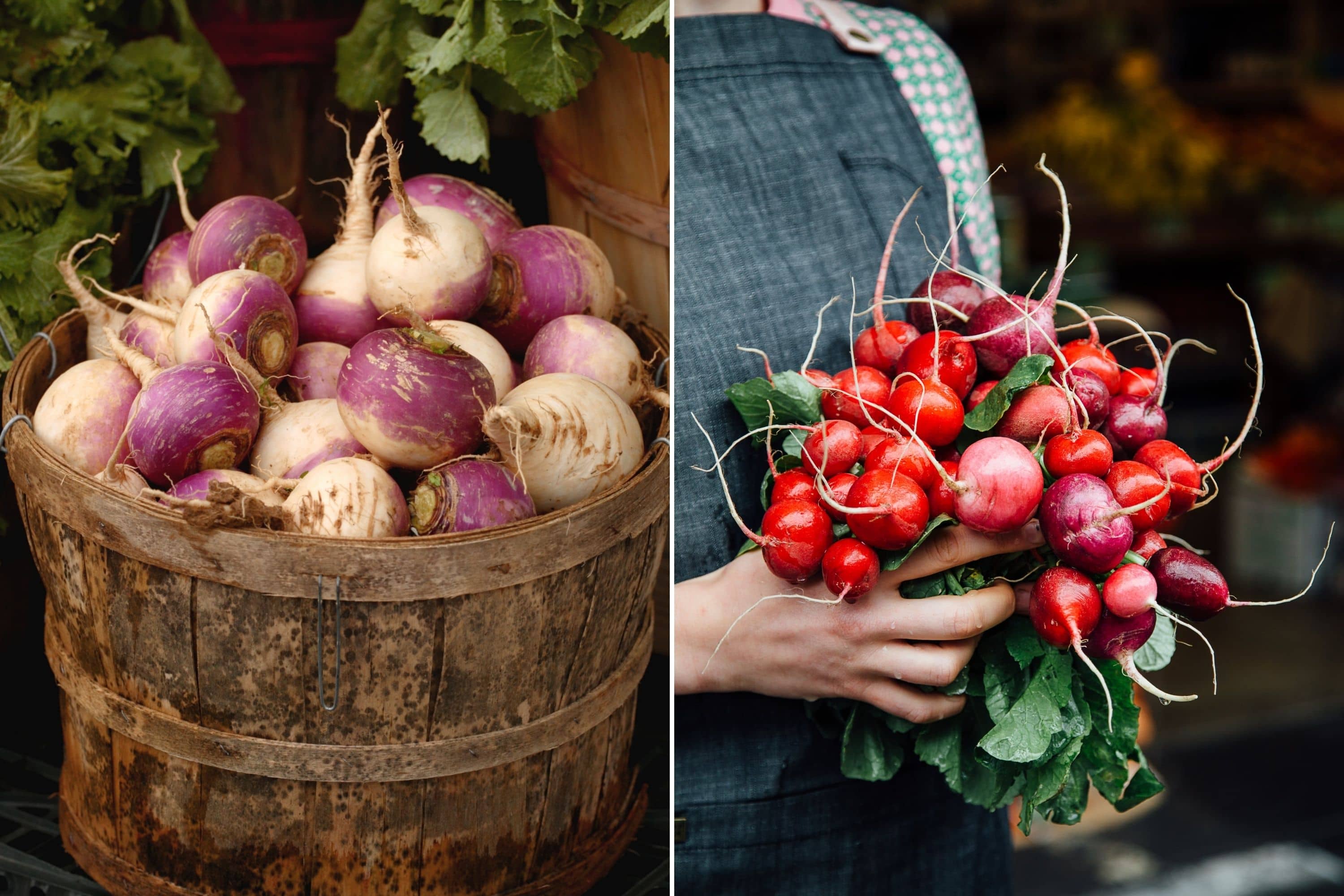
Can You Eat Raw Turnips?
We are mostly used to eating turnips cooked, for instance, fried, roasted, or steamed. And quite a few people think of eating this root vegetable raw. However, raw turnips is also consumable, and if you eat it like this, it will bring you even more benefits than in a cooked state.
Of course, you can simply peel the veggie, slice it, and chew it as it is, but it will taste much better in a salad if combined with cucumbers, tomatoes, greenery, and other veggies. By the way, you can experiment and search for the raw turnips recipes on the Internet. Be sure that you will find plenty of interesting options there that will make your meny way more varied!
Are Turnips Healthy?
Like any other raw vegetable, turnips are packed with nutrients and other beneficial elements. In addition, if you consume turnips regularly, you will notice that your digestion improves, as well as the health of your heart.
However, this is not a complete list of benefits that turnips give us! They also contribute to making our bones stronger and boost our immune system. No wonder that doctors and nutritionists often advise everyone to eat turnips raw or very lightly cooked (preferably steamed) to preserve all of these treasures!

How Rich Is Turnip In Vitamins And Nutrients?
Turnip is one of the foods that is very rich in different healthy things. This vegetable is known for containing calcium, and also such vitamins as A, E, C, K, as well as with B1, B2, B3, B5, and B6. Turnips also belong to the veggies that are rich in folate, manganese, and potassium. They contain iron, magnesium, and copper as well!
So it would be a crime if you don’t include this vitamin treasury into your daily menu. And since turnips can be cooked in many different ways and consumed not only mashed or fried, but also steamed, boiled, and roasted, we strongly recommend you rethinking your attitude to this veggie if it has been out of your sight until now.
[wp-faq-schema title=”Frequently Asked Questions”]
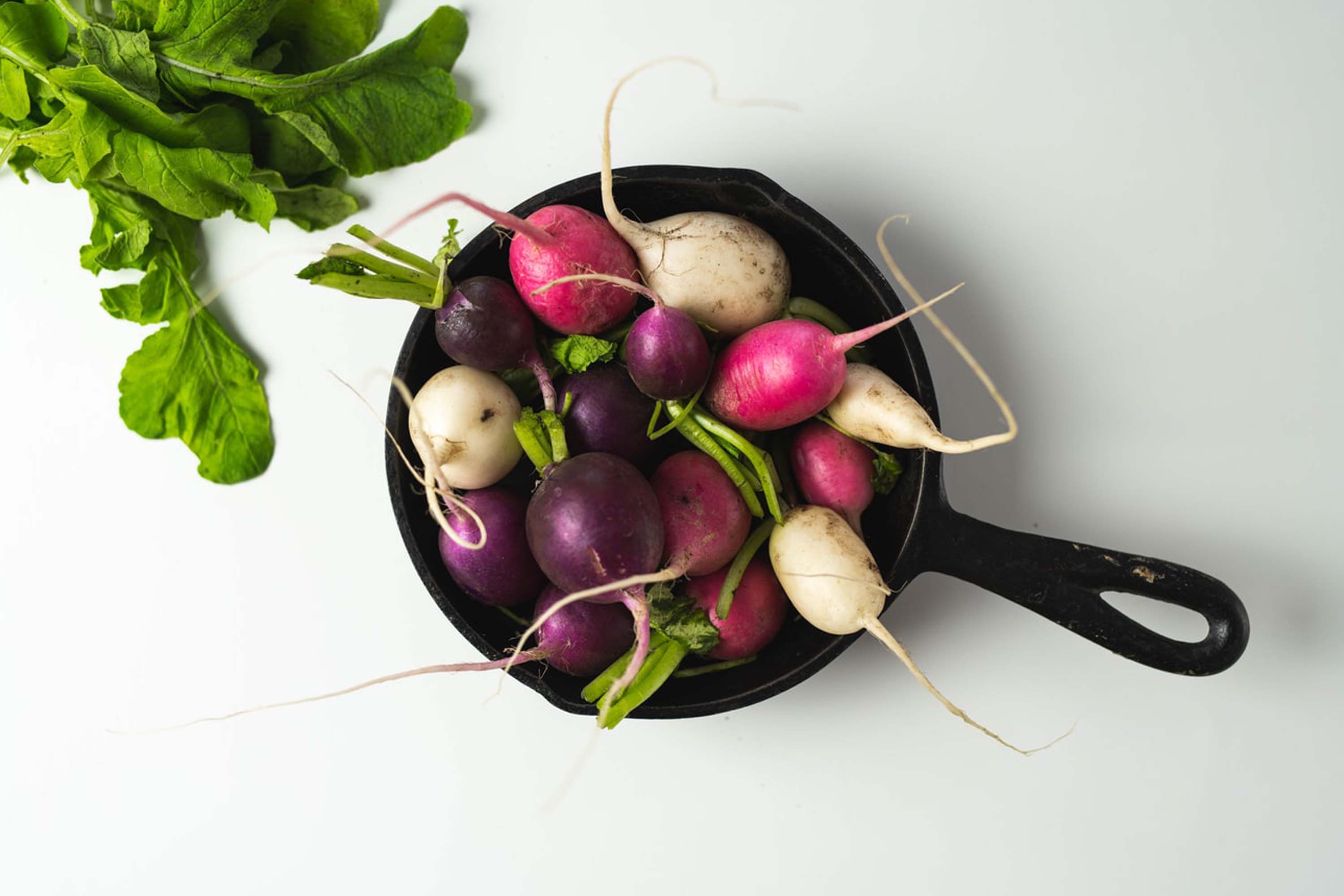
I’m extremely bad at telling the difference between certain veggies so maybe someone can explain to me what rutabaga is? What does a rutabaga taste like? Is it something like turnip, or no?
Hi! Well, rutabaga is indeed related to turnip if I recall it right. I’m not a farmer so I can’t advise you on this pretty much. As for the taste, I’d say it is somewhere in between the turnip and cabbage. I would define it as mild with slightly buttery and sweet-savory notes.
What do turnips look like? Are they those veggies that look like big radishes only being white and purple?
Yep, you are pretty much right! They resemble radish only being bigger, and yes, turnips are two-colored. The upper part is purple and the bottom part is white.
Hi everyone! I’ve got a question for you. I don’t use turnips that often, but this time I decided to change the scheme and try out some new recipes. So, the question is: can you eat turnip skin? Is it mandatory to peel it?
Yes, always peel it since the skin gives the root crop quite significant bitterness that I personally don’t like (and anyway, it’s pretty hard to get rid of).
Why is turnip bitter? How to get rid of that bitterness?
If you have a bitter root vegetable, then, perhaps, some skin got into the dish and you didn’t notice. Or the veggie was pretty old (old turnips are known for having that peppery flavor).